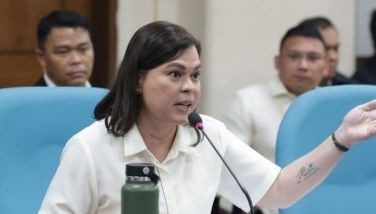Legazpi birth centennial
April 13, 2004 | 12:00am
Spain is celebrating the 5th centenary of the birth of Don Miguel Lopez de Legazpi, the first governor of the Philippine Islands. A native of Zubarraja, Spain, Legazpi landed at Cebu on April 27, 1565. He established a fort there and took possession of Manila on May 19, 1571 and established what is now the city of Manila on June 3, 1571 appointing its first regidors. He died on August 20, 1572. He was born in the early part of the sixteenth century, but no one knows the exact date. Following the custom, then, of people being baptized with the name of the saint of the day they were born, he was probably born on September 29, feast day St. Michael the Archangel. On just what year, no one has an inkling. Some historians claim that the Pasig River was named after Legazpi. El Pasig is an anagram of Legazpi.
In Spain, the Real Casa de la Moneda issued 25,000 limited edition of $10 Eurodollar in commemoration of Legazpi’s 500th birth centennial. And the State Corporation for Spanish Cultural Action Abroad and the National Museum of the Philippines are holding a joint exhibit called Philippines from Legazpi to Malaspina. The exhibit is on now at the National Museum in Manila. An exhibition is the most public activity of a museum.
We urge the public to see this exhibit. We hope that the schools and universities will take steps that their students view the exhibit. For as Thomas Carlyle said, "History is the first distinct product of man’s spiritual nature, his earliest expression of what can be called thought."
The world is now a global village and it is good to realize how it all started. When Spain expanded to South, Central and much of what is now the United States, her empire expanded even more then the Roman Empire did in 500 years. When she acquired the Philippines, she became the first empire where the sun never sets. It also marked the start of the longest shipping line in world history – the galleon trade. If the world is now a global village, its roots can be traced back to the Manila galleon trade that operated for 250 years! The first person who circumnavigated the globe was not Juan Sebastian de Elcano. He was a slave named Enrique, who may have been a Filipino because he could converse in Cebuano.
Of the current exhibit, Manila Mayor Jose L. Atienza Jr. says: "The arrival in Manila of Miguel Lopez de Legazpi, whose fifth birth centennial we are now celebrating, began a crucial stage in the formation of our country as he introduced western values such as Christianity that now forms an essential part of our identity as a people.
"Manila has always honored the memory of Miguel Lopez de Legazpi, whose statue can be found in the city’s central district. As such, we welcome with enthusiasm the prospect of being the principal venue, along with San Sebastian, of the fifth birth centennial of this great man.
"Proud of this cultural legacy, Manila continues to treasure its historical roots. This is why we consider cultural commemorations as the birth centennial of Miguel Lopez de Legazpi as important undertakings. This serves to strengthen ties that was forged out of a common past, and would also result in greater cooperation for genuine progress and prosperity for the peoples of Spain and the Philippines.
Thanks to Spain, the Philippines is now the third largest Catholic country in the world, next only to Brazil and Mexico.
In Spain, the Real Casa de la Moneda issued 25,000 limited edition of $10 Eurodollar in commemoration of Legazpi’s 500th birth centennial. And the State Corporation for Spanish Cultural Action Abroad and the National Museum of the Philippines are holding a joint exhibit called Philippines from Legazpi to Malaspina. The exhibit is on now at the National Museum in Manila. An exhibition is the most public activity of a museum.
We urge the public to see this exhibit. We hope that the schools and universities will take steps that their students view the exhibit. For as Thomas Carlyle said, "History is the first distinct product of man’s spiritual nature, his earliest expression of what can be called thought."
The world is now a global village and it is good to realize how it all started. When Spain expanded to South, Central and much of what is now the United States, her empire expanded even more then the Roman Empire did in 500 years. When she acquired the Philippines, she became the first empire where the sun never sets. It also marked the start of the longest shipping line in world history – the galleon trade. If the world is now a global village, its roots can be traced back to the Manila galleon trade that operated for 250 years! The first person who circumnavigated the globe was not Juan Sebastian de Elcano. He was a slave named Enrique, who may have been a Filipino because he could converse in Cebuano.
Of the current exhibit, Manila Mayor Jose L. Atienza Jr. says: "The arrival in Manila of Miguel Lopez de Legazpi, whose fifth birth centennial we are now celebrating, began a crucial stage in the formation of our country as he introduced western values such as Christianity that now forms an essential part of our identity as a people.
"Manila has always honored the memory of Miguel Lopez de Legazpi, whose statue can be found in the city’s central district. As such, we welcome with enthusiasm the prospect of being the principal venue, along with San Sebastian, of the fifth birth centennial of this great man.
"Proud of this cultural legacy, Manila continues to treasure its historical roots. This is why we consider cultural commemorations as the birth centennial of Miguel Lopez de Legazpi as important undertakings. This serves to strengthen ties that was forged out of a common past, and would also result in greater cooperation for genuine progress and prosperity for the peoples of Spain and the Philippines.
Thanks to Spain, the Philippines is now the third largest Catholic country in the world, next only to Brazil and Mexico.
BrandSpace Articles
<
>
- Latest
- Trending
Trending
Latest
Trending
Latest
Recommended

January 8, 2025 - 3:53pm




























